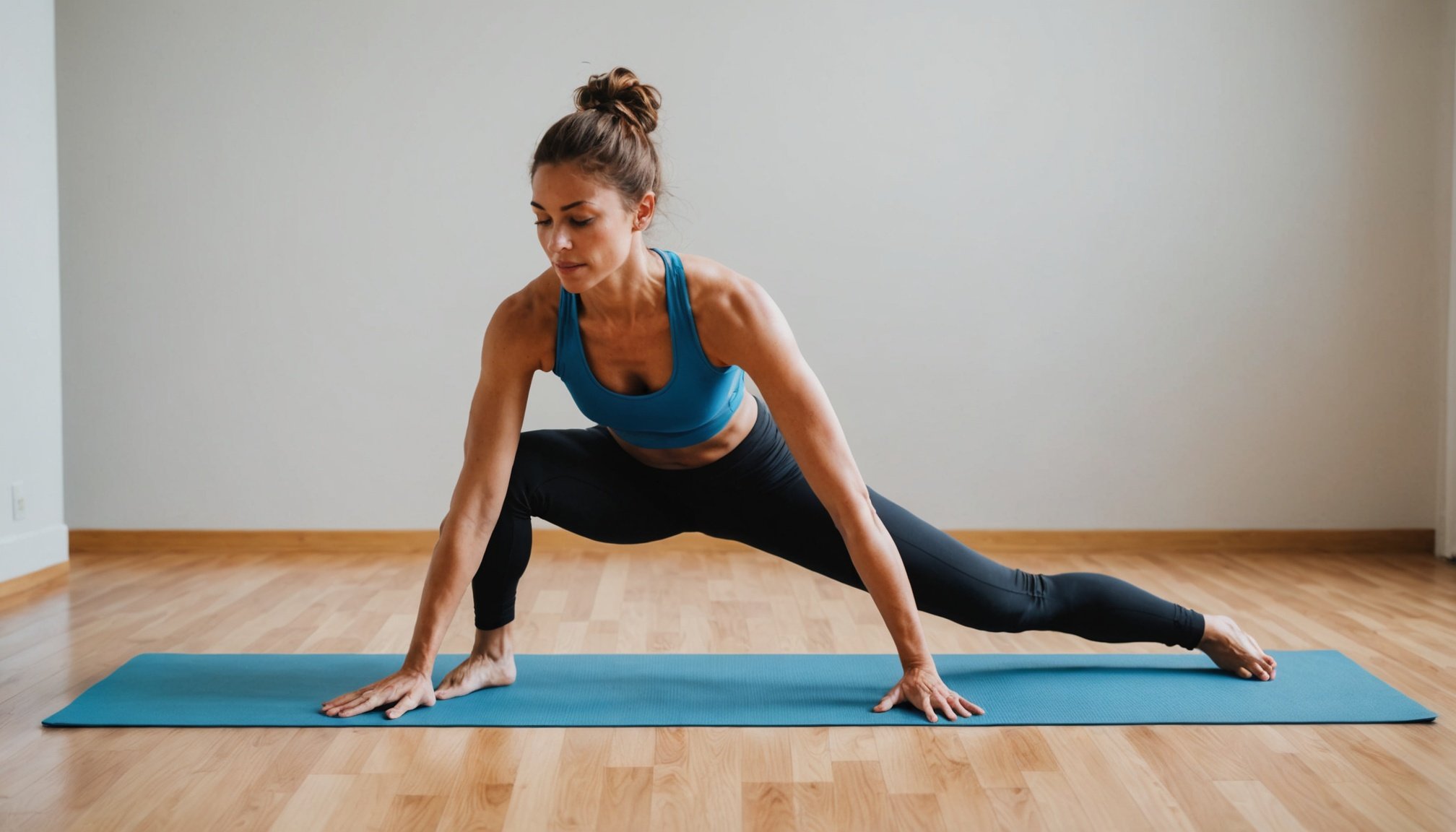Importance of Targeted Yoga for Hamstring Injury Recovery
Targeted yoga routines have emerged as a significant component in hamstring injury recovery. By concentrating on specific poses, these routines enhance both the flexibility and strength of hamstring muscles, which are often prone to tightness and injury. Incorporating yoga into a rehabilitation program offers numerous benefits. For one, the emphasis on mind-body connection helps individuals become more aware of their movements, reducing the risk of further injury.
Yoga also demands controlled breathing, which aids in managing pain and stress—two crucial elements in recovery. Moreover, certain yoga poses can be precisely chosen and adapted to focus on strengthening the hamstrings without overloading the injured muscle. This is where targeted yoga routines truly shine: they provide customisable programs suited to each person’s unique needs.
Also read : Mastering mental imagery: elevate athletic performance during high-stakes moments
A holistic approach that combines the principles of yoga with traditional physical therapy can significantly hasten recovery. Physical therapy offers structured exercises specifically aimed at healing the hamstrings, while yoga contributes balance and peace of mind. Bringing together these practices ensures a comprehensive treatment plan, optimising the chances for a complete and successful recovery. As a result, many practitioners increasingly recommend integrating targeted yoga into standard rehabilitative processes.
Recommended Yoga Poses for Hamstring Recovery
To aid in hamstring healing, specific yoga poses can be immensely beneficial. Each pose targets the hamstrings differently, promoting flexibility and strength slowly and safely.
Have you seen this : What are the benefits of integrating plyometric exercises into your routine?
Forward Fold Pose
The Forward Fold Pose offers a gentle stretch to the hamstrings. Begin by standing with feet hip-width apart. Inhale deeply, and as you exhale, hinge at the hips, allowing your torso to drape over your legs. Ensure your knees are slightly bent to avoid strain. For added support, place your hands on a block or the floor. This pose promotes a soothing release in the hamstrings, increasing elasticity over time.
Reclined Hand-to-Big-Toe Pose
Lie down and extend one leg toward the ceiling for the Reclined Hand-to-Big-Toe Pose. Use a strap or towel to loop around the extended foot, holding it with the same-side hand. Keep the opposite leg grounded. This stretch isolates the hamstrings, fostering flexibility and length.
Pyramid Pose
For the Pyramid Pose, begin in a standing position with one leg forward. Keep hips square as you lower your torso over the front leg. Support your hands on the ground or blocks. This pose aids in hamstring healing by promoting balance and gently stretching the target area. Adjust the depth of the stretch based on comfort and flexibility.
Structuring a Yoga Routine for Hamstring Recovery
Creating an effective yoga routine structure is crucial for hamstring recovery. An optimal recovery sequence usually begins with gentle stretches. Start with poses like Sukhasana (Easy Pose) to promote relaxation. Gradually move to Adho Mukha Svanasana (Downward-Facing Dog) which helps lengthen and strengthen the hamstrings.
When it comes to session planning, integrate Supta Padangusthasana (Reclining Hand-to-Big-Toe Pose) as it offers targeted stretching with control. Follow this with Janu Sirsasana (Head-to-Knee Forward Bend) to deepen flexibility over time. These poses work synergistically to enhance recovery.
Considering duration and frequency, aim for 20-30 minute sessions, 3-5 times a week. This regular practice balances intensity with rest, crucial for holistic recovery. Each pose can be held for 30 seconds to 1 minute, gradually increasing as comfort levels improve.
Breath work plays a vital role. Focus on controlled breathing to assist relaxation and extend stretch duration. Inhale deeply in poses to supply oxygen to muscles and exhale fully to deepen flexibility. Maintaining this focus mitigates injury risk and enhances your yoga routine structure for successful hamstring recovery.
Safety Tips for Practicing Yoga with Hamstring Injuries
Incorporating yoga safety techniques is crucial when dealing with hamstring injuries. To ensure a mindful practice, it is important to focus on injury prevention strategies.
Importance of Listening to Your Body
Listening to your body is paramount in yoga. Recognise discomfort as a signal to pause or adjust a pose. Instead of pushing through the pain, reflect on the sensations as part of injury prevention. This awareness not only prevents further injury but also deepens the yoga practice.
Knowing When to Modify or Skip Poses
Being mindful about when to modify or skip poses is essential. Certain movements may exacerbate a hamstring injury. Modify practices by focusing on less intense versions of poses. If discomfort persists, consider completely omitting the challenging postures to foster a healing environment.
Recommendations for Using Props (Blocks, Straps)
Utilising props like blocks and straps can enable safer practice. They offer extra support, making poses more accessible without compromising injury prevention. Blocks can assist with balance, while straps help in maintaining proper form, reducing strain on injured areas.
Guidance from a yoga professional or physical therapist can further enhance the practice, ensuring that each movement respects your body’s limitations. Educational resources are also invaluable for gaining a deeper understanding of body signals and adaptability in practice.
Testimonials and Case Studies from Athletes
In the world of athlete recovery stories, yoga has made a significant impact, proving to be a powerful tool for numerous athletes. Real-life examples highlight the profound effects of yoga on both physical and mental health. One such story is that of a professional basketball player who integrated yoga into his recovery routine. After suffering from a recurrent knee injury, he turned to yoga, which dramatically reduced his pain levels and enhanced flexibility, aiding his return to peak performance.
Yoga isn’t just about physical recovery, though. It profoundly affects mental well-being. An Olympic swimmer, once plagued by pre-race anxiety, found solace in yoga. Through regular practice, she developed better focus and calmness, crucial for her competitive races.
Furthermore, athletes have used targeted yoga routines not only for injury recovery but also for long-term prevention. A marathon runner, for instance, incorporated specific yoga poses into his training regimen, effectively building core strength and reducing the likelihood of future injuries.
These personal experiences testify to the transformative benefits of yoga, underlining its role in enhancing overall athlete wellness and performance longevity. The yoga impact is evident in every success story, highlighting its pertinence in sports recovery and maintenance.
Second Opinions and Professional Guidance
When contemplating yoga as a part of rehabilitation, seeking medical advice is crucial. Consulting a healthcare professional ensures that any exercise program is adjusted to your current physical state and health needs. Yoga can be beneficial, but without proper guidance, it might exacerbate the condition. Thus, a preliminary consultation can prevent potential setbacks and foster a safer transition into yoga practices.
Hamstring injuries, in particular, can vary from mild strains to severe tears, with each requiring tailored recovery strategies. Understanding the injury severity allows healthcare providers to recommend a customized rehabilitation plan. For instance, minor injuries might recover with rest and gentle stretching, while severe cases could necessitate surgical intervention or more extensive physical therapy.
Integrating yoga with traditional rehabilitation requires a balance to avoid overstressing the muscles. A specialized yoga instructor can adapt poses to suit the individual’s needs, complementing medically supervised treatments. This harmonious approach can facilitate comprehensive healing and, ultimately, a return to full mobility. Integrating both traditional and holistic methods ensures a versatile and effective path to recovery, fostering a proactive stance towards health improvement. Thus, professional guidance plays an indispensable role in managing and overcoming hamstring injuries with yoga.











